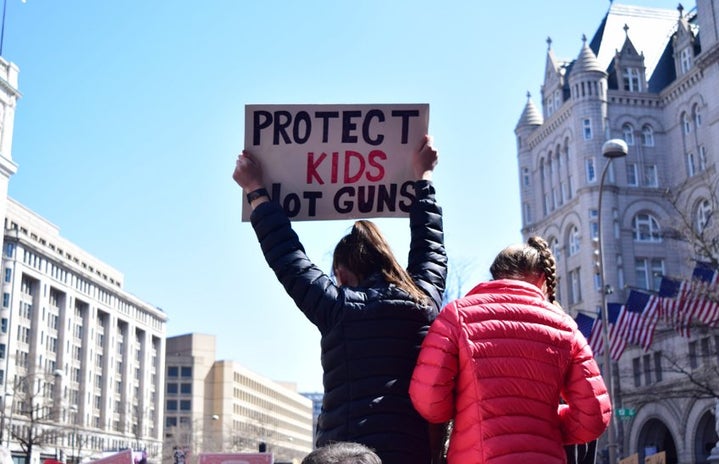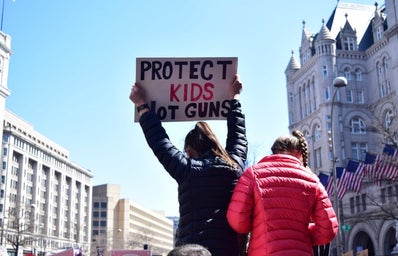It is difficult to adequately describe the immense privilege many of us have had as we scroll the notifications of our buzzing phones, glancing through headlines of “Six killed, including three children, in Tennessee school” among other social media alerts and text messages. Perhaps you read into the article a bit more, texted your mom about it, or sat with the notion of yet another in-school slaughter for a moment; but eventually, you got back to whatever it was you were doing before such notification caught your attention.
The increase in the commonality of school shootings makes for this unfortunate, seemingly emotionless reaction; this increase is evident through the fact that firearms are now the leading cause of death of children and teens, beating out the predecessor of motor vehicle accidents. Headlines of this nature largely result in small actions like the shaking of heads, asking “Again?”, and submitting “thoughts and prayers” to the communities affected. However, after years of these submissive reactions, little has been done to protect America’s school children from the weapons of mass tragedy that allow such incidents to continually occur – assault rifles with rapid-fire, large-capacity, self-loading magazines.
The AR-15-style rifles that the American p̶o̶p̶u̶l̶a̶t̶i̶o̶n̶ school children know all too well are reported to be “the most popular semi-automatic firearm(s)” by the National Rifle Association. The attractive massacre tool has been used in numerous mass shootings, including the recent Nashville Covenant School shooting (3 adults, 3 children slaughtered), as well as the Robb Elementary School Shooting (2 adults, 19 children slaughtered), and the Sandy Hook Elementary School Shooting (7 adults, 20 children slaughtered).
The list of mass shootings, and the amount of despair that accompanies each one, is virtually endless; though I observe an exceptional amount of grief pertaining to the deaths of elementary-school-aged children. This immense compassion may originate from my home proximity to Sandy Hook Elementary School, about thirty-five minutes away, as well as the fact that I was in the third grade when such tragedy struck. I remember being picked up from school that day by my mom and trying to comfort her as she cried as we drove home, despite not really understanding what had taken place earlier that day.
I remember her still crying later that night, my dad stone-faced, as we watched President Obama shed tears on television during his statement and later travel to our neighboring area to grant condolences to parents who now faced a blur between their worst nightmare and reality. I remember the police car that remained parked outside of my elementary school for the weeks to follow, chatter filling the halls as our young minds innocently questioned why it was there. Though this was a heartbreaking period for myself and my family, our feelings barely amounted to the levels of despair endured by the families of the victims of Sandy Hook Elementary School
…or Columbine High School
…or Virginia Tech
…or Umpqua Community College
…or Marshall County High School
..or Marjory Stoneman Douglas High School
…or Santa Fe High School
…or Central and Visual Performing Arts High School
…or the University of Virginia
…or Michigan State University, just to name a few.
Following the Sandy Hook Tragedy, a number of gun safety laws were quickly enacted in Connecticut, including a large-capacity magazine ban, a partial ghost gun ban, and a ban on the possession of assault rifles (unless an owner met ultra-specific criteria). However, legislation passed by single states is not enough. The 1994 Federal Assault Weapon Ban, more formally known as the Public Safety and Recreational Firearms Use Protection Act, was a ten-year ban signed by Bill Clinton to “prohibit the manufacture, transfer, or possession of a semi-automatic assault weapon,” as well as banning the possession or transfer of large-capacity ammunition devices. Though many were quick to point out the convoluted nature of the ban including its opportunities for people to find “loopholes,” statistics do reflect the effectiveness of the ban. An open-source data analysis reports that “…the federal ban period was associated with a statistically significant 9 fewer mass shooting related deaths per 10,000 firearm homicides. Mass shooting fatalities were 70% less likely to occur during the federal ban period.”
It is important to note that this ban was only in place for a mere ten years due to the sunset provision instilled by those against the ban, guaranteeing an expiration of the bill, and thus ensuring that it would have to go back through the lengthy legislative process to be reinstalled. By the time the ban expired in 2004, there was a new political climate in Washington, and the bill was not reinstated, as Republicans had tightened their grip in both the House of Representatives and Senate. Nonetheless, an alarmingly high contrast in the views of those in Congress, particularly on the topic of assault rifle bans, is more alive now than ever. It is saddening, and seemingly against the ideals of our democracy, to watch the gun lobby continuously triumph, in factoring influence, the growing list of innocent lives ruthlessly taken by such weapons.
The governmental focus will likely soon shift off the Nashville Covenant School tragedy until another catastrophic misfortune of a school shooting takes place. However, I urge readers to not let these events slip their minds too soon. While acceptance is certainly a part of the grieving process, it is ever important to remember victims and to acknowledge the horrific events that occurred. Ignorance is not bliss in these circumstances; ignorance is deadly. Educate yourself and others on the necessity of gun safety laws, donate to foundations that support these beliefs, and write to your state representatives and senators. Use social media to positively relay such information; do not support users/posts with content pondering the legitimacy of shootings as these are conspiracy theories that only insult the victims and their families. Yes – this is not uncommon.
I was scrolling on TikTok the other day and read through a comment section that speculated the authenticity of the Nashville Covenant Elementary School Shooting because the body cam footage was released “too quickly.” In reality, the footage was released in a timely manner. Many people are too used to situations like the Robb Elementary School Shooting where body cam footage was withheld for quite some time, likely because such footage exposed armed officers lazily and cowardly standing together and using the hand sanitizer dispenser on the wall in a hallway of the school, for over an hour, while schoolchildren took their final breaths. Immense kudos to the heroic Nashville police department for their quick and courageous sweep. They truly represent the best of this country. Nevertheless, this cycle is not how our country should function and change is undeniably necessary.

